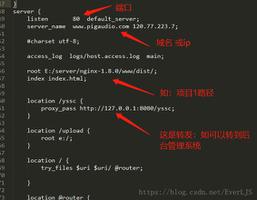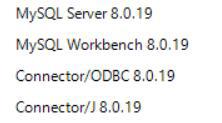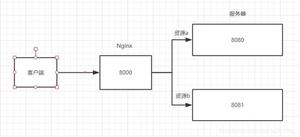Hadoop源码 – ipc.Server - java20130722

Hadoop源码 – ipc.Server
2013-04-16 18:15
java20130722
阅读(214)
评论(0)
编辑
收藏
举报
1、前言
昨天分析了ipc包下的RPC、Client类,今天来分析下ipc.Server。Server类因为是Hadoop自己使用,所以代码结构以及流程都很清晰,可以清楚的看到实例化、停止、运行等过程。
2、Server类结构
上面是Server的五个内部类,分别介绍一下:
1)Call
用以存储客户端发来的请求,这个请求会放入一个BlockQueue中;
2)Listener
监听类,用以监听客户端发来的请求。同时Listener下面还有一个静态类,Listener.Reader,当监听器监听到用户请求,便用让Reader读取用户请求。
3)Responder
响应RPC请求类,请求处理完毕,由Responder发送给请求客户端。
4)Connection
连接类,真正的客户端请求读取逻辑在这个类中。
5)Handler
请求(blockQueueCall)处理类,会循环阻塞读取callQueue中的call对象,并对其进行操作。
3、Server初始化
第一篇博客说了,Server的初始化入口在RPC.getServer中,getServer其实是调用的RPC.Server静态类中的构造方法,我们看看Namenode创建RPCServer的方法和RPC.Server构造方法代码:
private void initialize(Configuration conf) throws IOException { … this.serviceRpcServer = RPC.getServer(this, dnSocketAddr.getHostName(), dnSocketAddr.getPort(), serviceHandlerCount, false, conf, namesystem.getDelegationTokenSecretManager()); this.serviceRpcServer.start(); // 运行服务器 }
|
public Server(Object instance, Configuration conf, String bindAddress, int port, int numHandlers, boolean verbose, SecretManager<? extends TokenIdentifier> secretManager) throws IOException { super(bindAddress, port, Invocation.class, numHandlers, conf, classNameBase(instance.getClass().getName()), secretManager); this.instance = instance; this.verbose = verbose; }
|
该方法调用了父类的构造方法,如下:
protected Server(String bindAddress, int port, Class<? extends Writable> paramClass, inthandlerCount, Configuration conf, String serverName, SecretManager<? extends TokenIdentifier> secretManager) throws IOException { this.bindAddress = bindAddress; this.conf = conf; this.port = port; this.paramClass = paramClass; this.handlerCount = handlerCount; this.socketSendBufferSize = 0; this.maxQueueSize = handlerCount * conf.getInt( IPC_SERVER_HANDLER_QUEUE_SIZE_KEY, IPC_SERVER_HANDLER_QUEUE_SIZE_DEFAULT); this.maxRespSize = conf.getInt(IPC_SERVER_RPC_MAX_RESPONSE_SIZE_KEY, IPC_SERVER_RPC_MAX_RESPONSE_SIZE_DEFAULT); this.readThreads = conf.getInt( IPC_SERVER_RPC_READ_THREADS_KEY, IPC_SERVER_RPC_READ_THREADS_DEFAULT); this.callQueue = new LinkedBlockingQueue<Call>(maxQueueSize); this.maxIdleTime =2*conf.getInt("ipc.client.connection.maxidletime", 1000); this.maxConnectionsToNuke = conf.getInt("ipc.client.kill.max", 10); this.thresholdIdleConnections = conf.getInt("ipc.client.idlethreshold", 4000); this.secretManager = (SecretManager<TokenIdentifier>) secretManager; this.authorize = conf.getBoolean(HADOOP_SECURITY_AUTHORIZATION, false); this.isSecurityEnabled = UserGroupInformation.isSecurityEnabled(); // Start the listener here and let it bind to the port listener = new Listener(); this.port = listener.getAddress().getPort(); this.rpcMetrics = RpcInstrumentation.create(serverName,this.port); this.tcpNoDelay = conf.getBoolean("ipc.server.tcpnodelay",false); // Create the responder here responder = new Responder(); if (isSecurityEnabled) { SaslRpcServer.init(conf); } }
|
不难看出,父类的构造方法就初始化了一些配置和变量。
4、Server运行
在上面第一段代码中,还有一句RpcServer.start()的方法,在调用构造函数初始化一些变量之后,Server就可以正式运行起来了:
public synchronized void start() { responder.start(); listener.start(); handlers = new Handler[handlerCount]; for (int i = 0; i < handlerCount; i++) { handlers[i] = new Handler(i); handlers[i].start(); } }
|
responder、listener、handlers三个对象的线程均阻塞了,前两个阻塞在selector.select()方法上,handler阻塞在callQueue.take()方法,都在等待客户端请求。Responder设置了超时时间,为15分钟。而listener还开启了Reader线程,该线程也阻塞了。
4、Server接受请求流程
1)监听到请求
Listener监听到请求,获得所有请求的SelectionKey,执行doAccept(key)方法,该方法将所有的连接对象放入list中,并将connection对象与key绑定,以供reader使用。初始化玩所有的conne对象之后,就可以激活Reader线程了。
void doAccept(SelectionKey key) throws IOException, OutOfMemoryError { Connection c = null; ServerSocketChannel server = (ServerSocketChannel) key.channel(); SocketChannel channel; while ((channel = server.accept()) != null) { channel.configureBlocking(false); channel.socket().setTcpNoDelay(tcpNoDelay); Reader reader = getReader(); try { reader.startAdd(); // 激活readSelector,设置adding为true SelectionKey readKey = reader.registerChannel(channel); c = new Connection(readKey, channel, System.currentTimeMillis()); readKey.attach(c); synchronized (connectionList) { connectionList.add(numConnections, c); numConnections++; } … } finally { reader.finishAdd(); // add完毕,设置adding为false,Reader开始工作 } } }
|
2)接收请求
Reader的run方法和Listener基本一致,也是获得所有的SelectionKey,再执行doRead(key)方法。该方法获得key中绑定的connection,并执行conection的readAndProcess()方法:
void doRead(SelectionKey key) throws InterruptedException { int count = 0; Connection c = (Connection)key.attachment(); // 获得连接对象 if (c == null) { return; } c.setLastContact(System.currentTimeMillis()); try { count = c.readAndProcess(); // 接受并处理请求 } catch (InterruptedException ieo) { … } if (count < 0) { … closeConnection(c); c = null; } else { c.setLastContact(System.currentTimeMillis()); } }
|
public int readAndProcess() throws IOException, InterruptedException { // 一次最多读取一次RPC请求,如果头没读完,继续迭代直到 // 读完所有请求数据 while (true) { int count = -1; if (dataLengthBuffer.remaining() > 0) { count = channelRead(channel, dataLengthBuffer); … if (!rpcHeaderRead) { //读取请求头. if (rpcHeaderBuffer == null) { rpcHeaderBuffer = ByteBuffer.allocate(2); } count = channelRead(channel, rpcHeaderBuffer); if (count < 0 || rpcHeaderBuffer.remaining() > 0) { return count; } // 读取请求版本号 int version = rpcHeaderBuffer.get(0); byte[] method = new byte[] {rpcHeaderBuffer.get(1)}; authMethod = AuthMethod.read(new DataInputStream( new ByteArrayInputStream(method))); dataLengthBuffer.flip(); … dataLengthBuffer.clear(); … rpcHeaderBuffer = null; rpcHeaderRead = true; continue; } … data = ByteBuffer.allocate(dataLength); } // 读取请求 count = channelRead(channel, data); if (data.remaining() == 0) { … if (useSasl) { saslReadAndProcess(data.array()); } else { // 执行RPC请求,先解析header请求,下次循环解析param请求 processOneRpc(data.array()); } … } return count; } }
|
3)获得call请求
在Connection中解析param请求中,解析了请求数据,并构造Call对象,将其加入callQueue。
private void processData(byte[] buf) throws IOException, InterruptedException { DataInputStream dis = new DataInputStream(new ByteArrayInputStream(buf)); int id = dis.readInt(); // 读取请求id … Writable param = ReflectionUtils.newInstance(paramClass, conf);// 获取参数,paramClass是参数的实体类,在构造Server对象的时候传入 param.readFields(dis); Call call = new Call(id, param, this); callQueue.put(call); // 添加进阻塞队列,不过队列有max限制,有可能也会阻塞 incRpcCount(); }
|
4)处理call对象
Connection给callQueue添加了call对象,阻塞的Handler可以继续运行了,拿出一个call对象,并调用RPC.Call方法
// 关键代码 while (running) { final Call call = callQueue.take(); // 弹出call对象 CurCall.set(call); value = call(call.connection.protocol, call.param, call.timestamp); // 调用RPC.Server中的call CurCall.set(null); synchronized (call.connection.responseQueue) { setupResponse(buf, call, (error == null) ? Status.SUCCESS : Status.ERROR, value, errorClass, error); … responder.doRespond(call); } }
|
5)响应请求
上面代码中的setupResponse将call的id和状态发送回去,再设置了call中的response:ByteBuffer,之后就开始responder.doRespond(call)了,processResponse以及Responder.run()没太弄明白,就先不说了。
void doRespond(Call call) throws IOException { synchronized (call.connection.responseQueue) { // 这行没懂 call.connection.responseQueue.addLast(call); if (call.connection.responseQueue.size() == 1) { // 返回响应结果,并激活writeSelector processResponse(call.connection.responseQueue,true); } } }
|
6、总结
Server用的标准的Java TCP/IP NIO通信,同时请求的超时使用基于BlockingQueue以及wait/notify机制实现。使用的模式是reactor模式,关于nio和reactor可以参考这个博客。
对于服务器端接收多个连接请求的需求,Server采用Listener来监听连接的事件,并用Listener.Reader来监听网络流读以及Responder监听写的事件,当有实际的网络流读写时间发生之后,解析了请求Call之后,添加进阻塞队列,并交由多个Handlers来处理请求。
这个方法比TCP/IP BIO好处就是可接受很多的连接,而这些连接只在真实的请求时才会创建线程处理,称之为一请求一处理。但是,连接上的请求发送非常频繁时,TCP/IP NIO的方法并不会带来太大的优势。
但是Hadoop实际场景中,通常是服务器端支持大量的连接数(Namenode连上几千个Datanode),但是连接发送的请求并不会太多(heartbeat、blockreport都有较长间隔)。这样就造成了Hadoop不适合实时的、多请求的运算,带来的代价是模型、实现简单,但是这也为以后的扩展埋下了祸根。
P.S.: 以上分析基于稳定版0.20.203.0rc1。
以上是 Hadoop源码 – ipc.Server - java20130722 的全部内容,
来源链接:
utcz.com/z/391422.html










